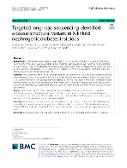Targeted long-read sequencing identified a causal structural variant in X-linked nephrogenic diabetes insipidus

Author
Černá, Monika
Zavoral, Tomáš
Komrsková, Pavla
Tejcová, Jitka
Sládková, Eva
Šubrt, Ivan
Publication date
2024Published in
BMC Medical GenomicsVolume / Issue
17 (1)ISBN / ISSN
ISSN: 1755-8794ISBN / ISSN
eISSN: 1755-8794Metadata
Show full item recordCollections
This publication has a published version with DOI 10.1186/s12920-024-01801-1
Abstract
Background: X-linked nephrogenic diabetes insipidus (NDI) is a rare genetic renal disease caused by pathogenic variants in the AVPR2 gene. Single nucleotide variants and small insertions/deletions in AVPR2 are reliably detected by routine clinical sequencing. Nevertheless, structural variants involving AVPR2 are challenging to identify accurately by conventional genetic testing. Here, we report a novel deletion of AVPR2 in a Czech family identified for the first time by targeted long-read sequencing (T-LRS).Methods: A male proband with X-linked NDI underwent clinical sequencing of the AVPR2 gene that failed and thus indicated possible whole-gene deletion. Therefore, PCR mapping and subsequent targeted long-read sequencing (T-LRS) using a Pacific Biosciences sequencer were applied to search for the suspected deletion. To validate the deletion breakpoints and prove variant segregation in the family with X-linked NDI, Sanger sequencing of the deletion junction was performed. Quantitative real-time PCR was further carried out to confirm the carrier status of heterozygous females.Results: By T-LRS, a novel 7.5 kb deletion of AVPR2 causing X-linked NDI in the proband was precisely identified. Sanger sequencing of the deletion junction confirmed the variant breakpoints and detected the deletion in the probands' mother, maternal aunt, and maternal cousin with X-linked NDI. The carrier status in heterozygous females was further validated by quantitative real-time PCR.Conclusions: Identifying the 7.5 kb deletion gave a precise molecular diagnosis for the proband, enabled genetic counselling and genetic testing for the family, and further expanded the spectrum of structural variants causing X-linked NDI. Our results also show that T-LRS has significant potential for accurately identifying putative structural variants.
Keywords
Long-read sequencing, PacBio, Breakpoint analysis, AVPR2 deletion, Nephrogenic diabetes insipidus
Permanent link
https://hdl.handle.net/20.500.14178/2226License
Full text of this result is licensed under: Creative Commons Uveďte původ 4.0 International







